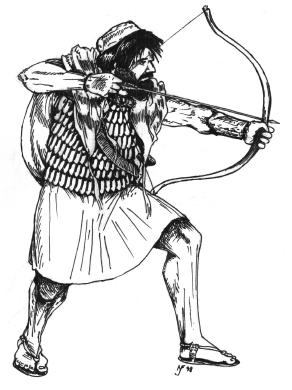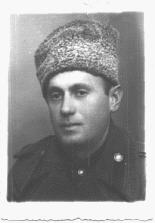By Norman J. Finkelshteyn
Ancient, Classical,
and Modern Eras
Yemen (Himayar)
Beyond The Sambation -
The Jews of Ethiopia
(the Bata Yisrael or Falashas)
The Middle East -
Muslim Conquests through The Crusades
Spain before the Expulsion
The Khazar Kaganate
Persia and Central Asia
Refugees from Spain and Portugal
Caveats in Researching Jewish History
Hairstyle of the Jewish Khazar
Israel Today --
Notes on the Current Conflict
Copyright and Authoring information
Norman Finkelshteyn's
Armour History Site
http://www.geocities.com/normlaw
Visit
Silk Road Designs Armoury
http://www.enteract.com/~silkroad
 A defender of Massada See brief discussion below. |
Less intuitive, but just as well known, and thus little meriting repetition are the uprisings of the Jews against the Roman invasion. The struggle of the Jews for independence from occupation lasted for two hundred years, at the end of which, the Romans were only able to win by burning Jerusalem to the ground and exiling the majority of the population of Israel. The illustration at the right is based on one of the more famous battles of those wars against the Romans -- the three year siege of the fortress Massada -- memorialized in the modern slogan of Israel "Massada shall never fall again!" A brief discussion of the illustrated event appears below.

|
Who fought against the NAZIs as an Elite Cavalry Commander during World War II. |
When fighting may have been thought impossible, the Jewish warrior spirit proved itself, fighting the NAZI military juggernaught in the Uprising of the Warsaw Ghetto and the many cells of Freedom Fighters throughout German-occupied Europe (with the most famous cell, and consisting mostly of Jews -- The Partisans of Vilna).
The photograph at the left shows a Jewish warrior of World War II -- typical of the best, a man of peace who went to war to fight evil.
For the upheavals of the nineteen twenties, I recommend the writings of Isaac Baavel, the Jewish Cossack poet of the Russian Civil War. Finally, at the bottom of the main page you will find a section and links dealing with some heroes today -- Israeli soldiers Missing in Action.
This article, however, will concentrate on the period when the image of the "Weak Jew" arose, the time between the Roman exile and the Enlightment -- on the Middle Ages, when most think of Jews as either Shylock or Isaac of York.
| Main Page | Next Page (Yemen) |
|---|